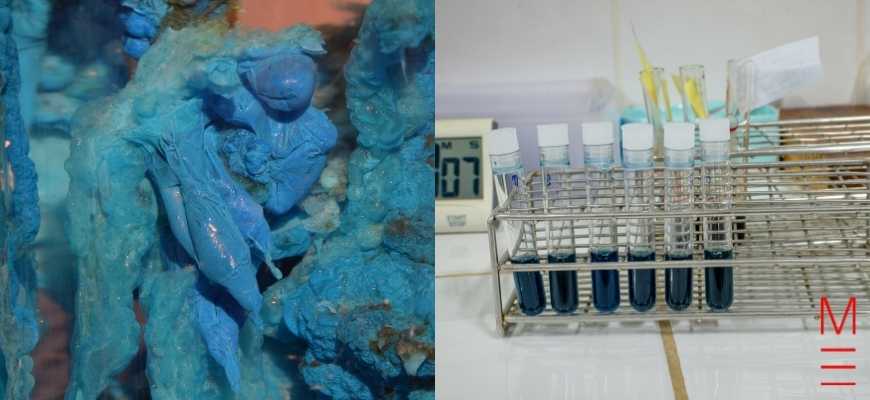Welcome to Matrix Education
To ensure we are showing you the most relevant content, please select your location below.
Select a year to see courses
Learn online or on-campus during the term or school holidays
Learn online or on-campus during the term or school holidays
Learn online or on-campus during the term or school holidays
Learn online or on-campus during the term or school holidays
Learn online or on-campus during the term or school holidays
Learn online or on-campus during the term or school holidays
Learn online or on-campus during the term or school holidays
Get HSC Trial exam ready in just a week
Get HSC exam ready in just a week
Select a year to see available courses
Science guides to help you get ahead
Science guides to help you get ahead

Guide Chapters
Need to bring equilibrium back to your chemistry marks? Read our Guide to Module 5: Equilibrium and Acid Reactions and revise your Chemistry dot points.
In this Beginner’s Guide, we will explain HSC Chemistry Module 5: Equilibrium and Acid Reactions and its topics.
You can see the full list of syllabus outcomes for HSC Chemistry on NESA’s website here.
Before Year 12, we mainly focused on irreversible reactions, where reactants simply convert into products. However, many reactions are reversible: reactants convert to products while products convert back to reactants simultaneously. We show this using a reversible arrow: ⇌
Irreversible reactions will go to completion and reach a state called static equilibrium where the rate of the forward and reverse reaction will be zero, and the concentrations of the reaction components remain constant. In other words, there will be no microscopic or macroscopic changes.
Reversible reactions do not go to completion and will reach a dynamic equilibrium where the forward and reverse rates of reaction are equal but non-zero, resulting in the concentrations of reaction components remaining constant. In other words, there are microscopic changes occurring, but they cancel out to produce no overall macroscopic change.
Dynamic equilibria have a special property: when disturbed, the system will undergo a reaction (a shift) that minimises the effect of the disturbance. This is known as Le Chatelier’s principle.
You will need to be able to predict the shift that will occur when a disturbance is applied, and justify why the shift occurs with reference to Le Chatelier’s principle.
Possible disturbances:
There are two other changes that are often mentioned: addition of an inert gas (at constant volume), and addition of a catalyst. These do not disturb the equilibrium, and result in no shift.
To answer Le Chatelier’s principle questions, you can use the following flow chart:
We can also use the collision theory to explain the way an equilibrium shifts in response to a disturbance. Recall from Year 11:
You must be able to explain how each disturbance affects to the relative rates of the forward and reverse reactions.
As well as discussing equilibrium qualitatively, we can also analyse and describe it quantitatively, with reference to the equilibrium constant, which has the symbol K, Keq or Kc. The equilibrium constant is a numerical value that gives us information about the relative quantities of reactants and products at dynamic equilibrium.
For a general reversible reaction, we derive the equilibrium constant from the following expression:
a A + b B ⇌ c C + d D
We determine the equilibrium constant by substituting equilibrium concentrations of each reaction component into the expression.
There are a few important things to remember about the equilibrium constant:
To interpret:

When the concentrations of the reaction components at any point in the reaction are substituted into the expression for K, it is called Q, the reaction quotient. The relative values of Q and K will allow you to predict the shift in an equilibrium.
For example, adding additional “D” to the equilibrium above will result in a Q that is larger than K. To reach equilibrium, i.e. obtain K, the reverse reaction will speed up, causing the equilibrium to shift left to produce more reactants.
If the temperature changes, the equilibrium constant also changes. We can predict the resulting change using Le Chatelier’s principle.
Often you will have to calculate the value of the equilibrium constant from non-equilibrium concentrations. A way of solving these questions is by using an ICE table:
The process for solving these questions is:
Here’s an example of how you can use an ICE table to solve a question from the 2021 HSC Chemistry Exam.
\(\)Let 0.45 + x = the initial concentration of nitrogen gas required in the vessel to increase the amount of ammonia by 0.050 moles
Concentration (M) | N2(g) | 3H2(g) | 2NH3(g) |
Initial | 0.45 + x | 0.1 | 0.58 |
Change | – 0.0025 | – 0.0075 | + 0.005 |
Equilibrium | 0.4475 + x | 0.0925 | 0.585 |
\begin{align*}
K = \frac{[NH_3]^2 }{[N_2][H_2]^3 } &= 748 \\
\frac{0.5852}{((0.4475 + x) \times 0.09253} &= 748 \\
\frac{0.5852}{3.5417} \times 10-4 + 0.09253x &= 748 \\
0.5852 &= 748 (3.5417 \times 10-4 + 0.09253x) \\
0.5852 &= 0.264923 + 0.592006x \\
x &= 0.5852 – \frac{0.264923}{0.592006} \\
&= 0.130576 \text{mol /L} \\
\text{Nitrogen gas needed to be added} &= 0.130576 \text{mol /L} \times 10 \text{L} \\
&= 1.30576 \text{mol}
\end{align*}
Thus, add 1.3 mol of nitrogen gas (2 s.f.)
Some questions will ask you to calculate the concentrations of reactants or products at equilibrium, given initial concentrations and the value of K. We can solve these calculations using an ICE table.
You will generally need to use the pronumeral 𝑥 in the ICE table, then substitute the equilibrium concentrations (in terms of 𝑥) into the expression for the equilibrium constant. Then you can solve for 𝑥 and calculate the equilibrium concentrations.
To solve these questions, sometimes you’ll need to solve a quadratic or a cubic equation, which can be time-consuming and difficult (you are likely to make some silly errors!). Instead, you can make an assumption that drastically simplifies the calculation:
In other words, if the initial concentration of the reactant is 0.5 M, we round the concentration at equilibrium (0.5 – 𝑥, where 𝑥 is some negligible change) to 0.5 M.
There are some common equilibrium reactions that chemists encounter. We use special equilibrium constant symbols to represent these reactions.
The dissolution of an ionic compound reaches a dynamic equilibrium in a saturated solution. For example, in a saturated solution of calcium chloride, the following equilibrium is present:
CaCl2(s) ⇌ Ca2+(aq) + 2Cl–(aq)
Calcium chloride is dissolving into ions at the same rate as calcium and chloride ions are precipitating.
The solubility product constant represents the equilibrium constant for this reaction, written in the direction of dissolution. It has the symbol Ksp.
Since the reactant is always a solid, there is no term in the denominator. For calcium chloride, the expression for Ksp is:
Ksp = [Ca2+][Cl–]2
Most of the time, solubility product questions involve slightly soluble or insoluble substances, since it does not take much compound to produce a saturated solution. You can find all the Ksp values that you need for the compounds in your exams in the NESA data sheet.
You will need to be able to perform a variety of calculations involving solubility products. The most common ones are calculating Ksp from solubility, and calculating solubility from Ksp.
When an ion that is already in the solution is added (a common ion), the solubility of the compound decreases. This is known as the common ion effect.
For example, when we add sodium chloride (containing chloride ions) to a solution of calcium chloride, the equilibrium shifts to the left to produce more solid.
You will need to be able to perform calculations based on the common ion effect; for example, calculating the solubility of calcium chloride in a solution of sodium chloride.
When two solutions are mixed, precipitation may occur. This depends on the concentrations of the solutions being mixed, and the identity of the ions involved. We can also calculate the quantity that has precipitated with reference to Ksp.

As well as performing calculations, you will also need to be able to discuss solubility equilibria qualitatively, in terms of bonding and entropy.
Recall from Year 11 that bonding includes both chemical bonds (ionic bonds and covalent bonds), as well as intermolecular forces (hydrogen bonding, dipole-dipole interactions, ion-dipole forces, dispersion forces).
You learned about entropy in Module 4, Drivers of Reactions. Entropy refers to the dispersal of available energy. When energy can be dispersed in more ways (greater microstates), entropy increases. Entropy is sometimes also referred to as a measure of disorder in the system.
Acids are substances that can dissociate to produce hydrogen ions in solution. Strong acids will ionise completely, but weak acids will only partially ionise, forming an equilibrium. For example, hydrofluoric acid is weak, and ionises reversibly:
HF(aq) ⇌ H+(aq) + F-(aq)
The acid dissociation constant, Ka, represents the equilibrium constant for the ionisation of an acid. For hydrofluoric acid, the expression for Ka is:
We will explore acids and bases further in Module 6 (Acid/Base Reactions).
© Matrix Education and www.matrix.edu.au, 2025. Unauthorised use and/or duplication of this material without express and written permission from this site’s author and/or owner is strictly prohibited. Excerpts and links may be used, provided that full and clear credit is given to Matrix Education and www.matrix.edu.au with appropriate and specific direction to the original content.